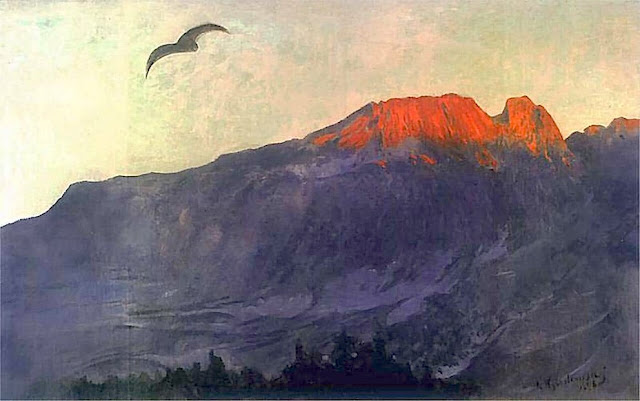WLASYSLAW JAROCKI (1879-1965)
Massif du Giewont (1, 895 m- 6, 217 ft)
Pologne
In " Zakopane en hiver - Vue de Giewont", huile sur toile, 51,5 x 71,3 cm, 1950, Muzeum KUL
Le peintre
Władysław Jarocki est artiste peintre polonais, né en Ukraine. Il étudia à l'Université nationale polytechnique de Lviv, où il obtient son diplôme d'architecture, puis dans les années 1902 à 1906 à l'Académie des beaux-arts de Cracovieoù il fut l'élève de Józef Mehoffer et Leon Wyczółkowski. Entre 1907 et 1909 il perfectionna ses compétences à Paris à l'Académie Julian. En 1909, il devint membre de la «Sztuka» Société des artistes polonais, un groupe qui réunissait alors l'élite d'artistes polonais. En 1910, il adhéra à la Sécession viennoise. En 1911, il partit en voyage d'études en Italie, puis s'installa à Lviv. En tant que sujet de l'Empire austro-hongroise il servit dans l'armée de 1915 à 1916, documentant ses expériences sur le champ de bataille avec de très émouvants dessins. En 1917, Ii met à profit ses études d'architecture en dirigeant la reconstruction architecturale du quartier de Lviv pour le compte du Comité national de reconstruction de la Galice. En 1920, il prend des fonctions d'enseignant de dessin à l'Institut polytechnique de Lviv et à l'École industrielle d'État. L'année suivante, il devient professeur associé à l'Académie des Beaux-Arts de Cracovie. Il gravit progressivement les échelons de la hiérarchie universitaire, devenant doyen de la Faculté de peinture et de sculpture de 1925 à 1928 ; il fut vice-chancelier de 1933 à 1935 et nommé professeur ordinaire de peinture en 1937. Pendant l'occupation nazie, de 1940 à 1943, il dirigea le département de graphisme de la Städtische Handwerker- und Kunstgewerbeschule de Cracovie. Après la guerre, il ne retourna pas à l'enseignement ; il prit sa retraite en 1947. Dans l'histoire de l'art polonais, l'héritage artistique de Jarocki est associé au folklore, aux images de la campagne, aux coutumes paysannes colorées et aux rituels des régions Hutsul et Podhale. Ces motifs folkloriques qui restent indéniablement aujourd'hui liés à son œuvre avaient attiré son attention dès ses études polytechniques.
La montagne
Giewont est un massif montagneux des Tatras en Pologne qui culmine à 1 895 m. Le massif compte trois sommets (tous en m/mètres en AMSL) :
- Grand Giewont - Wielki Giewont (1 895 m - 6 217 pi)
- Long Giewont - Długi Giewont (1 867 m - 6 125 pi)
- Petit Giewont - Polonais Mały Giewont (1 728 m - 5 669 pi)
Un col de montagne sépare le Grand et le Long Giewont, connu sous le nom de Szczerba (1 823 m - 5 980 pi). Le Long Giewont et le Grand Giewont sont situés à une altitude plus élevée que la ville voisine de Zakopane, ce qui les rend clairement visibles depuis cette ville.
Au sommet du Grand Giewont, on peut apercevoir une croix en acier de 15 m de hauteur érigée en 1901, qui marque l 'arrivée d'un site de pèlerinages religieux. Cette zone est connue pour dangerosité surtout en période d'orages. La première ascension su sommet de Giewont a été entreprise en 1830 par Franciszek Herbich et Aleksander Zawadzki (un explorateur du 19ème siècle). La première ascension hivernale du Giewont a eu lieu en 1904 par un groupe de cinq alpinistes dirigé par Mariusz Zaruski. De nos jours, l'escalade du Giewont est strictement interdite. Par contre, la randonnée sur les sentiers est autorisée et d'un l'accès plutôt facile (sauf en hiver), ce qui explique pourquoi le Giewont est une destination très populaire chez les promeneurs et les touristes. En été, plusieurs milliers de touristes ptentent aisni de s'approcher du sommet chaque jour.
_________________________________________
2023 - Wandering Vertexes ....
Errant au-dessus des Sommets Silencieux...
Un blog de Francis Rousseau
,%20przed%201950,%20Muzeum%20KUL..jpg)


















